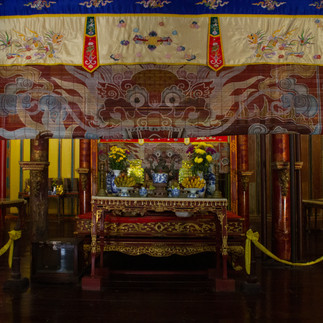A Journey Through History: Exploring the Majestic Tomb of Minh Mang in Vietnam
- Luke Stoffel

- Oct 6, 2021
- 3 min read
Updated: May 8, 2024
Hue, Vietnam
Photography by Lucas Stoffel can be licensed on Shutterstock and Getty Images
Minh Mang Tomb by Lucas Stoffel
Nestled within the lush landscapes and historic cityscape of Hue, Vietnam, lies the Tomb of Minh Mang, a testament to the architectural and artistic brilliance of the Nguyen Dynasty. This majestic tomb, located about 12 kilometers southwest of Hue's city center, is a captivating destination that offers travelers a glimpse into Vietnam's imperial past.
A Dynasty of Emperors
Built during the early 19th century, the Tomb of Minh Mang is the final resting place of Nguyen Phuc Dam, known as Emperor Minh Mang. He was the second ruler of the Nguyen Dynasty and reigned from 1820 to 1841. Minh Mang's reign was characterized by significant political and administrative reforms, including the construction of several impressive architectural marvels throughout the empire.

Minh Mang Tomb by Lucas Stoffel
The Perfect Fusion of Nature and Architecture
As you approach the tomb, you'll be struck by its harmonious integration with the natural surroundings. The tomb's design is a testament to the Confucian principles of balance and symmetry. It is enclosed by a rectangular wall, symbolizing the earth, and surrounded by a serene body of water, representing the sea.
The Salient Features:
Courtyard of the Stele Pavilion: The journey through the tomb begins at the courtyard of the Stele Pavilion, where a stone tablet inscribed with Emperor Minh Mang's accomplishments stands proudly. It's a testament to his contributions and visionary leadership.
Honoring Nature: As you proceed further, you'll pass through pristine gardens and along serene ponds connected by ornate bridges. The landscape is meticulously designed to harmonize with the natural environment.
The Tomb Area: At the heart of the complex lies the tomb area, where the Emperor's remains are interred. His tomb, although simple in design, exudes an air of grandeur and reverence. Its focal point is the majestic triple-roofed gate.
Pavilion of Splendor: To the rear of the tomb, the Pavilion of Splendor stands as an exquisite architectural masterpiece. The pavilion's intricate artwork and detailing showcase the craftsmanship of the Nguyen Dynasty.
Minh Mang Tomb by Lucas Stoffel
The Tomb of Minh Mang, A Tranquil Retreat
Visiting the Tomb of Minh Mang is not just an exploration of history but also an opportunity for tranquility and reflection. The carefully manicured gardens, meandering pathways, and the serene ambiance make it a serene retreat from the hustle and bustle of modern life. It's a place where the beauty of nature blends seamlessly with the artistic expressions of human creativity.
Practical Information
Opening Hours: The tomb is generally open to visitors from morning until late afternoon. It's recommended to check the exact timings when planning your visit.
Entrance Fee: There is an entrance fee to visit the tomb, which helps maintain and preserve this historical site.
Attire: Dress respectfully when visiting, as this is a place of historical and cultural significance.
Getting There: You can reach the Tomb of Minh Mang by taxi, motorbike, or as part of a guided tour of Hue's historical sites.
The Tomb of Minh Mang is not just a historical relic but a living testament to the grandeur of the Nguyen Dynasty's architectural and artistic achievements. Visiting this awe-inspiring tomb allows travelers to step back in time, experience the rich heritage of Vietnam, and marvel at the intricate fusion of art and nature. It's a journey through history that leaves a lasting impression on all who visit.









Comments